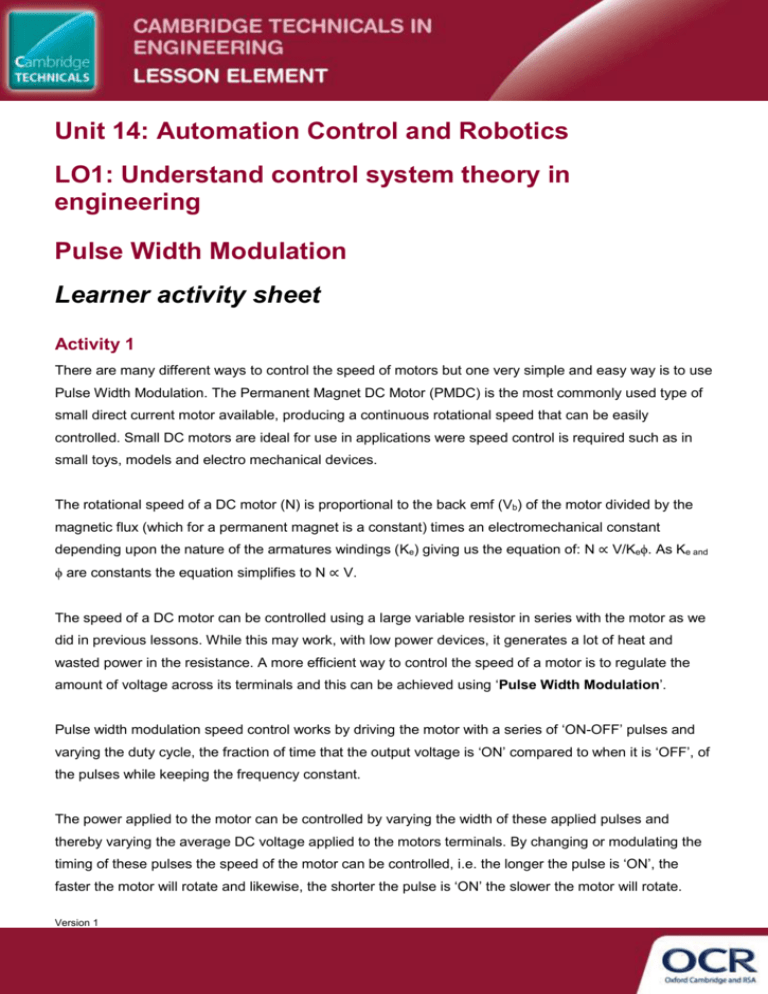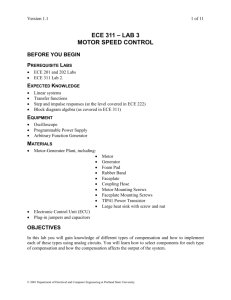Pulse width modulation
advertisement

Unit 14: Automation Control and Robotics LO1: Understand control system theory in engineering Pulse Width Modulation Learner activity sheet Activity 1 There are many different ways to control the speed of motors but one very simple and easy way is to use Pulse Width Modulation. The Permanent Magnet DC Motor (PMDC) is the most commonly used type of small direct current motor available, producing a continuous rotational speed that can be easily controlled. Small DC motors are ideal for use in applications were speed control is required such as in small toys, models and electro mechanical devices. The rotational speed of a DC motor (N) is proportional to the back emf (Vb) of the motor divided by the magnetic flux (which for a permanent magnet is a constant) times an electromechanical constant depending upon the nature of the armatures windings (Ke) giving us the equation of: N ∝ V/Keϕ. As Ke and ϕ are constants the equation simplifies to N ∝ V. The speed of a DC motor can be controlled using a large variable resistor in series with the motor as we did in previous lessons. While this may work, with low power devices, it generates a lot of heat and wasted power in the resistance. A more efficient way to control the speed of a motor is to regulate the amount of voltage across its terminals and this can be achieved using ‘Pulse Width Modulation’. Pulse width modulation speed control works by driving the motor with a series of ‘ON-OFF’ pulses and varying the duty cycle, the fraction of time that the output voltage is ‘ON’ compared to when it is ‘OFF’, of the pulses while keeping the frequency constant. The power applied to the motor can be controlled by varying the width of these applied pulses and thereby varying the average DC voltage applied to the motors terminals. By changing or modulating the timing of these pulses the speed of the motor can be controlled, i.e. the longer the pulse is ‘ON’, the faster the motor will rotate and likewise, the shorter the pulse is ‘ON’ the slower the motor will rotate. Version 1 The use of pulse width modulation to control a small motor has the advantage in that the power loss in the switching transistor is small because the transistor is either fully ‘ON’ or fully ‘OFF’. As a result the switching transistor has a much reduced power dissipation giving it a linear type of control which results in better speed stability. Also the amplitude of the motor voltage remains constant so the motor is always at full strength. The result is that the motor can be rotated much more slowly without it stalling. We can produce a pulse width modulation signal to control the motor by using an Astable 555 Oscillator circuit as shown below. Version 1 This simple circuit based around the familiar NE555 or 7555 timer chip is used to produce the required pulse width modulation signal at a fixed frequency output. The timing capacitor C is charged and discharged by current flowing through the timing networks RA and RB. The output signal at pin 3 of the 555 is equal to the supply voltage switching the transistors fully ‘ON’. The time taken for C to charge or discharge depends upon the values of RA, RB, which are adjusted by the variable resistor VR1. The capacitor charges up through the network RA but is diverted around the resistive network RB and through diode D1. As soon as the capacitor is charged, it is immediately discharged through diode D2 and network RB into pin 7. During the discharging process the output at pin 3 is at 0 V and the transistor is switched ‘OFF’. Then the time taken for capacitor, C to go through one complete charge-discharge cycle depends on the values of RA, RB and C with the time T for one complete cycle being given as: The time, TH, for which the output is “ON” is: TH = 0.693(RA).C The time, TL, for which the output is “OFF” is: TL = 0.693(RB).C Total “ON”-“OFF” cycle time given as: T = TH + TL with the output frequency being ƒ = 1/T Calculate the vales of TH, TL and frequency ƒ, for the value of VR1 set to minimum (0Ω), mid-point (50KΩ) and maximum (100KΩ). What would the average output voltage be at each of these three points? What would happen to the frequency ƒ if the capacitor C was replaced with one of value 4.7µF? What would be the effect on the motor operation with it operating at this frequency? Version 1 Activity 2 If you have access to a circuit as shown in activity 1, or other pwm device, connect it to the motor used in the open loop control lesson. Note: Only apply a 6v power supply to the above circuit or you will damage the components. Adjust the potentiometer and observe the output speed. How does the pwm compare with the potentiometer used in the open loop control lesson? If you are able to, replace the capacitor C with one with a value of 4.7µF. Observe what happens. Insert the pwm device into the circuit used for the closed loop control lesson. Observe how it operates in this circuit and what happens when you apply a load to the motor. Version 1







